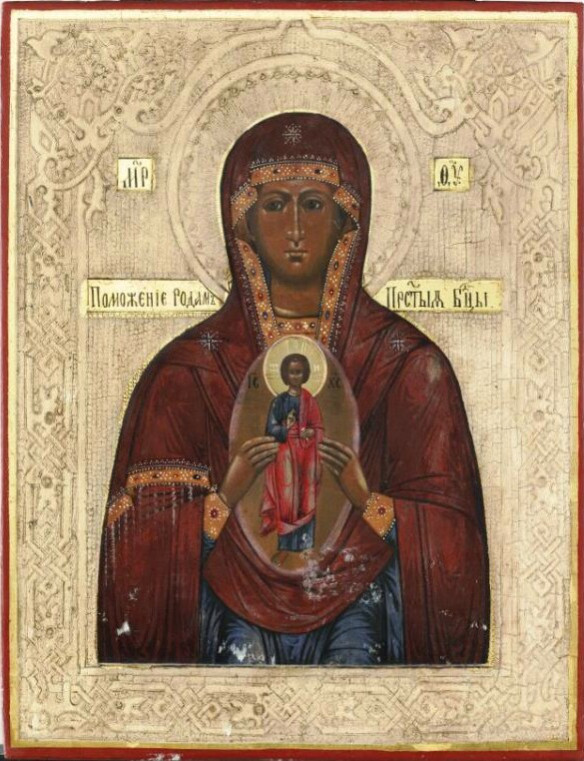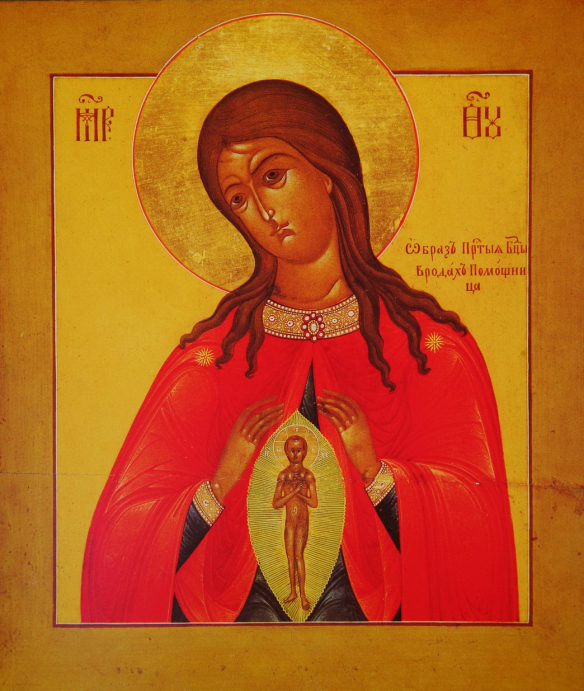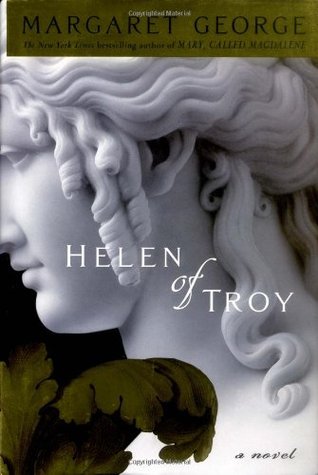Childbirth was a very serious matter in Russia in the days before modern medical care. Being a difficult time for women, they turned to what comfort they could get from an icon considered to specifically help with the difficulties of birth.
There are two variants of icons on this theme, and their names tend to be confused in practice.
The first is called (not surprisingly), Помощь В Родах — Pomosch v Rodakh — the “Help in Birth,” or some slight variation on that such as Помощница В Родах — Pomoshchnitsa v Rodakh — “Helper in Birth,” etc. Here is an example

(Courtesy of The Museum of Russian Icons, Clinton MA)
The title here reads Поможение Родам’ Пресвятыя Богородицы — Pomozhenie Rodam Presvyatuiya Bogoroditsui — “[The] Help in Birth Most Holy Mother of God.”
As you see, it is somewhat similar in form to the Znamenie (“Sign”) type, except in the “Helper” the mother’s hands are held inward at an ellipse with the Child Christ (Immanuel, Logos) in it. In some modern examples, the hands are held below the ellipse.
The second variant is called «Помогательница женам чады рождаты» “Helper of Women in Birthing Children.” But as already mentioned, the title given this type is often one of the same used for the first variant, as we see in this example, which is titled:

ОБРАЗЪ ПРЕСВЯТЫЯ БОГОРОДИЦЫ В РОДАХЪ ПОМОЩНИЦА
OBRAZ PRESVYATUIYA BOGORODITSUI V RODAKH POMOSHCHNITSA
“IMAGE OF THE MOST HOLY MOTHER OF GOD IN BIRTH HELPER”
Or in normal English order,
“The Image of the Most Holy Mother of God ‘Helper in Birth.'”
In this second variant, Mary’s head is bare, with her long hair visible; her head nods slightly to the side, and her hands are held inward but above the mandorla/clipeus in which the naked Christ Child stands. In some examples the hands meet, with fingers overlapping, or are held in prayer. So this is another of those few types in which Mary is shown bareheaded, a likely indication of borrowing from Roman Catholicism, because showing Mary with loose hair is not typically Eastern Orthodox. That is probably why some copies add a headcovering to this type.
Examples of these “midwives’ icons” began to appear in Russia in the 19th century, which is why old examples one sees are only from the 19th-early 20th century. Modern copies — both painted but more often printed — are quite common.
A supposedly “wonderworking” example of this type “appeared” as late as 1993, when Protopriest Vladimir Andreyev was giving communion to an old woman in her home. She told her granddaughter to go to the attic and get an icon. An old copy of the “Helper in Childbirth” was brought down, covered with dust, soot, and cobwebs, and having a darkened metal cover (riza/oklad). The old lady gave it to Protopriest Vladimir Andreyev. The icon was cleaned, and supposedly began to work miracles involving childbirth and infertility. It is kept in the Cathedral of St. Nicholas ‘The White’ (Собор Николы Белого) in the city of Serpukhov ( Серпухов).
With these two type variants, expect also variations in title and in form from copy to copy.
Advertisements Share this:




